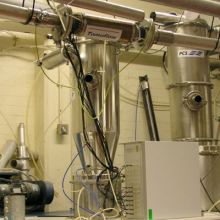Atout Process is undertaking a market study for dry solids flowmeters.
The report will cover:
Applications
Current technologies, their performance and limitations
Current players in the market
New technologies and their potential
The study is being undertaken on a collective basis – please contact us if you would like to participate and receive a copy of the report. Publication due 30 April 2012.
Background
The output of a flowmeter tells the user how much material is passing through the meter at a certain time, either as a volume flowrate (for example litres per second) or as a mass flowrate (for example tonnes per hour). The measurement of flowrate may then be integrated to give the total amount of material delivered, for example the number of litres or tonnes. In the case of liquids and gases the technology to measure flow is well understood and flowmeters are widespread – whether filling up a car on a garage forecourt or measuring gas consumed by a household, the amount of product is measured by a flowmeter and the indicated output of the flowmeter is accepted by both buyer and seller as the true amount delivered.
Many industrial processes use mixtures of products pumped along pipes. For example, in manufacturing processes particulate materials (plastics, grain, catalysts…) are blown along pipes by compressed air or pumped in liquid, while in the oil business mixtures of gas, oil and water are common in long-distance transport. Such transport systems are very efficient, but the only way to measure the amount delivered is to separate the components and meter them individually or to fill some sort of tank or vessel and measure the volume or the weight of the product in the tank. This limitation is not inherent to the pumping mechanism, it is simply that the technology for measuring the flowrate of mixtures of materials in pipes by a flowmeter is highly limited. The lack of flowmeter technology for these applications adds to the cost of the operation considerably (extra piping, valves, tanks and weighing mechanisms) and interferes with the process flow.
Applications for dry solids flowmeters include gravity flow measurement, flow splitting, and pneumatic conveying in many areas, examples include:
- Grain processing
- Cement and minerals transport
- Fluidisation and reaction of products inside chemical reactors
- Fluidisation, gravity flows or pneumatic conveying of solid particles (such as plastic pellets, sand, cement, coal or grain).
- Fluidized product drying
- Fluidized combustion, including coal gasification and clean coal technology
- Oil and gas drilling including cementing quality control, solids delivery from supply vessels etc.
- Combustion monitoring, including jet and rocket engines and explosive devices
- Monitoring of continuous mixing
and in a number of industries including:
- Food
- Animal feed
- Chemical
- Mineral
- Fertilizer
- Rubber & plastics
- Pharmaceutical
- Glass
- Power generation
- Oil and gas exploration and production

